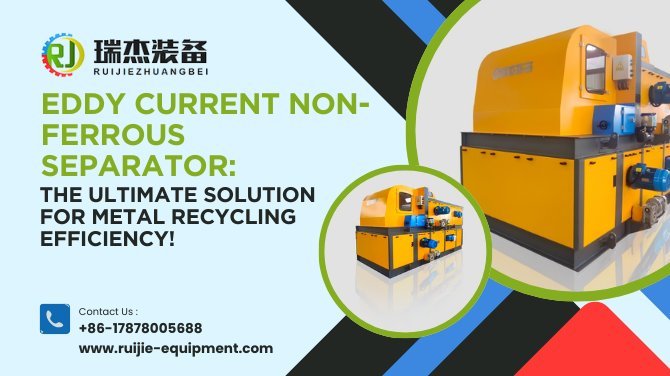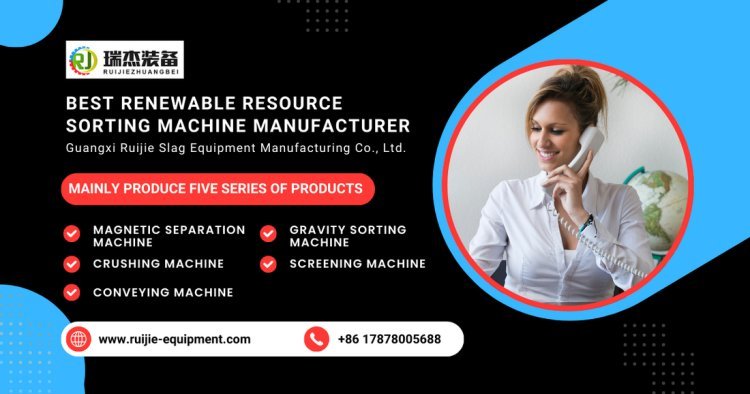Eddy Current Non-Ferrous Separator: The Ultimate Solution for Metal Recycling Efficiency!

In today’s fast-paced industrial world, the demand for more efficient recycling processes is growing rapidly. With an increasing need for sustainability and reducing the environmental impact of waste, metal recycling has become an essential part of modern industrial operations. One of the most important technological advancements in this field is the eddy current non-ferrous separator. This powerful machine is revolutionizing how industries separate non-ferrous metals from various waste materials, offering a highly efficient and effective solution.
At Guangxi Ruijie Slag Equipment Manufacturing Co., Ltd., we are dedicated to providing cutting-edge equipment that helps optimize metal recycling operations. Our eddy current non-ferrous separators are designed with the latest technology to enhance the separation process of non-ferrous metals like aluminum, copper, and brass from mixed materials, including industrial waste, electronic waste (e-waste), and municipal solid waste (MSW). These separators offer high precision and efficiency, making them the ultimate solution for any metal recycling operation aiming to increase recovery rates and reduce waste.
Understanding the Eddy Current Non-Ferrous Separator
The eddy current non-ferrous separator is a specialized machine used in the recycling industry to separate non-ferrous metals—such as aluminum, copper, and zinc—from a stream of mixed waste or recyclable materials. It operates based on the principle of eddy currents, which are circular electric currents that are induced in conductive materials when exposed to a changing magnetic field.
The eddy current separator uses a rotating magnetic drum or conveyor system to generate a rapidly alternating magnetic field. This magnetic field induces eddy currents in the non-ferrous metals, causing them to experience a repulsive force that makes them separate from the rest of the material stream. The machine works incredibly fast and efficiently, ensuring that valuable metals are recovered while minimizing the contamination of the remaining material.
How Does an Eddy Current Non-Ferrous Separator Work?
The operation of the eddy current non-ferrous separator involves a series of steps that ensure the successful separation of non-ferrous metals from other materials. Let’s break down the key components and steps involved in this process:
The Magnetic Rotor
At the heart of the eddy current separator is the magnetic rotor. The rotor contains a set of magnets that create a high-frequency alternating magnetic field. As materials move through the rotor’s magnetic field, eddy currents are induced in the conductive non-ferrous metals. These metals are then subject to a repulsive force from the magnetic field, causing them to be ejected from the material flow.
Material Input
The materials to be sorted are fed onto a conveyor belt. These materials typically consist of mixed waste, including metals, plastics, glass, and other non-metallic substances. The materials are then guided through the magnetic rotor’s field, where the sorting process takes place.
Separation Process
When the non-ferrous metals enter the magnetic field, the eddy currents induce a repulsive force, which pushes the metals away from the rest of the material stream. This force causes the non-ferrous metals to be separated and collected in a designated compartment, while the remaining materials continue along the conveyor for further processing or disposal.
Residual Material Processing
After the non-ferrous metals are separated, the remaining materials—such as ferrous metals, plastics, and other debris—can be further processed or sorted using other techniques, depending on the type of waste stream and the desired outcome.
Key Advantages of Using an Eddy Current Non-Ferrous Separator
The eddy current non-ferrous separator offers a multitude of benefits over traditional separation methods. From improving recovery rates to reducing environmental impact, this technology is transforming the metal recycling landscape. Let's examine some of the main benefits:
High Efficiency
One of the primary advantages of using an eddy current non-ferrous separator is its efficiency. These machines can separate non-ferrous metals from waste materials at a much faster rate than manual sorting or other traditional methods. With the ability to process large volumes of material quickly, recyclers can achieve higher throughput and significantly increase their productivity.
Precision in Separation
The precision of the eddy current separator allows it to separate non-ferrous metals with remarkable accuracy. This is especially important when dealing with mixed waste streams, as the machine can efficiently extract even the smallest non-ferrous metal particles. This high level of precision ensures that the final product is clean, reducing contamination and improving the overall quality of the recycled material.
Reduced Labor Costs
By automating the separation process, the eddy current non-ferrous separator reduces the need for manual labor. This not only lowers operational costs but also minimizes the risk of human error, resulting in more consistent and reliable results.
Environmental Impact Reduction
Eddy current separators contribute to sustainability efforts by enabling the recycling of valuable non-ferrous metals, which would otherwise go to waste. These metals can be reused in various industries, such as construction, automotive, and electronics, reducing the need for mining and conserving natural resources. Additionally, by reducing waste sent to landfills, the machine helps reduce the overall environmental impact.
Cost-Effectiveness
While the initial investment in an eddy current non-ferrous separator may be significant, the long-term cost savings are substantial. With higher recovery rates, reduced labor costs, and improved material quality, recyclers can increase their profitability and improve their return on investment.
Applications of the Eddy Current Non-Ferrous Separator
The versatility of the eddy current non-ferrous separator allows it to be used across a wide range of industries and recycling applications. The following are a few of the most popular uses:
Metal Recycling Plants
In metal recycling facilities, eddy current non-ferrous separators are used to extract valuable non-ferrous metals from mixed scrap metal. This includes materials like aluminum, copper, and zinc, which can be sold and reused in various industrial applications.
E-Waste Recycling
The growing issue of electronic waste (e-waste) has created a demand for advanced recycling methods. Eddy current non-ferrous separators are essential in e-waste recycling, as they help recover valuable metals like copper and aluminum from discarded electronics, such as computers, televisions, and smartphones.
Automotive Recycling
When vehicles are recycled, they contain a variety of materials, including metals, plastics, and rubber. Eddy current separators are commonly used to separate non-ferrous metals from the rest of the materials, making the recycling process more efficient and profitable.
Municipal Solid Waste (MSW) Recycling
In municipal solid waste recycling, eddy current separators help recover non-ferrous metals from mixed waste streams. This includes everything from household waste to industrial waste, helping reduce contamination and improve the quality of recycled materials.
How Guangxi Ruijie Slag Equipment Manufacturing Co., Ltd. Leads the Way in Eddy Current Separator Technology
At Guangxi Ruijie Slag Equipment Manufacturing Co., Ltd., we are committed to providing the highest-quality eddy current non-ferrous separators for the recycling industry. Our separators are designed with advanced technology to ensure optimal performance, efficiency, and durability.
With years of experience in manufacturing slag and metal separation equipment, we understand the unique needs of recycling facilities. Our team of experts works tirelessly to deliver machines that can handle even the toughest recycling challenges while delivering exceptional results.
The Future of Eddy Current Non-Ferrous Separators in Recycling
As the global focus on sustainability intensifies, the demand for eddy current non-ferrous separators is expected to grow. In the coming years, we anticipate significant advancements in this technology, including improvements in magnetic materials, automation, and sensor capabilities. These innovations will further enhance the performance and versatility of these separators, making them even more effective in a wide range of applications.
Moreover, as regulations around waste disposal and recycling become more stringent, the role of eddy current separators in ensuring compliance and maximizing recovery rates will continue to be essential for the success of recycling operations.
The eddy current non-ferrous separator has proven to be a game-changer in the world of metal recycling. By offering unmatched efficiency, precision, and cost-effectiveness, it has become an indispensable tool for recycling facilities worldwide. Whether it’s for recovering valuable non-ferrous metals, reducing waste, or enhancing sustainability efforts, these separators are leading the way toward a more efficient and environmentally responsible recycling industry.
At Guangxi Ruijie Slag Equipment Manufacturing Co., Ltd., we are proud to offer state-of-the-art eddy current non-ferrous separators that help our customers achieve their recycling goals. By investing in our cutting-edge technology, you can stay ahead of the competition and contribute to a cleaner, more sustainable future.
Frequently Asked Questions
- 1. How does an eddy current non-ferrous separator work?
The eddy current separator works by inducing eddy currents in non-ferrous metals using a high-frequency magnetic field. These eddy currents cause the metals to experience a repulsive force, separating them from other materials.
- 2. What types of materials can be separated with an eddy current non-ferrous separator?
The eddy current separator is primarily used to separate non-ferrous metals, such as aluminum, copper, and brass, from mixed waste or recyclable materials.
- 3. How efficient are eddy current separators?
Eddy current separators are highly efficient and can process large volumes of materials quickly. They also provide high precision in separating non-ferrous metals with minimal contamination.
- 4. Can an eddy current separator be used for e-waste recycling?
Yes, eddy current separators are commonly used in e-waste recycling to recover valuable metals like copper, aluminum, and precious metals from discarded electronics.
- 5. What are the environmental benefits of using an eddy current non-ferrous separator?
By recovering valuable non-ferrous metals and reducing waste sent to landfills, eddy current separators contribute to a more sustainable and environmentally friendly recycling process.
What's Your Reaction?














